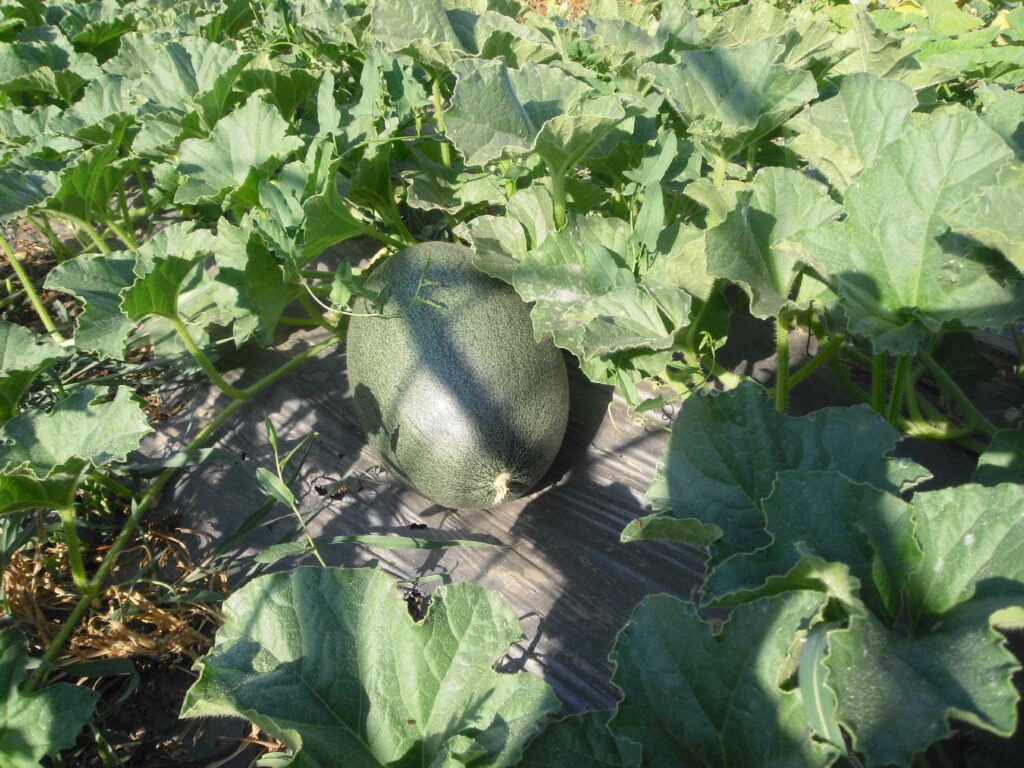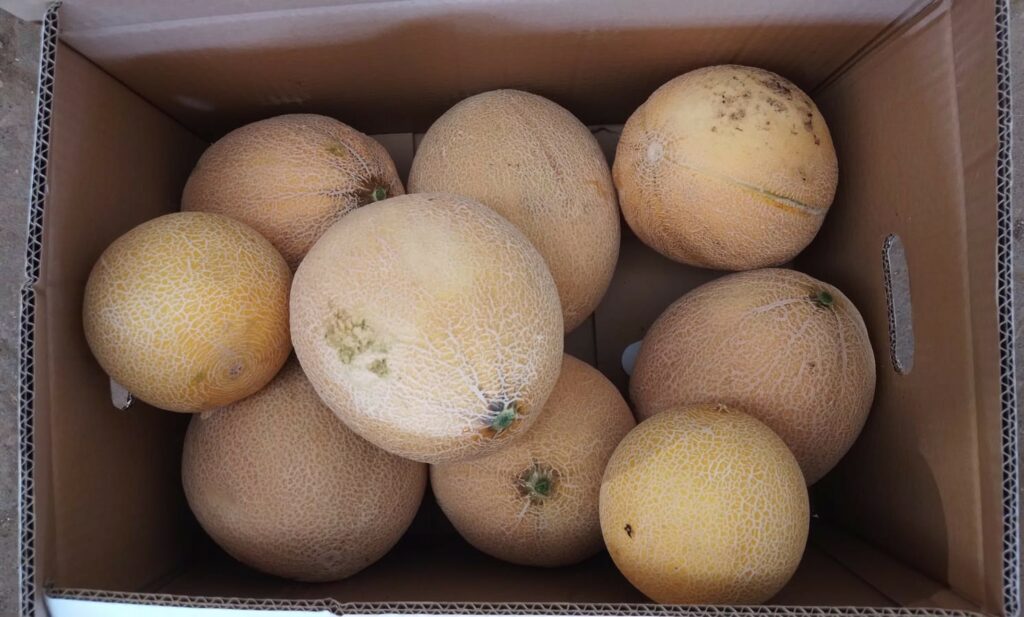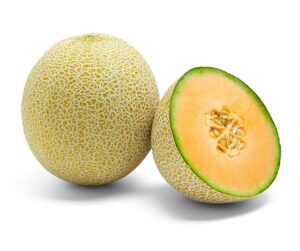For some weeks now, you’ve been receiving sweet, aromatic, elliptic fruit in your boxes. So this week’s sweet summery newsletter is dedicated to the fruit that almost makes this month’s heatwaves worth it, or at the least provides a measure of comfort: the melon.
While we at Chubeza maintain the identity of veggie farmers working the land and growing vegetables, there was a moment or two when we considered planting a small fruit orchard. In the end, we decided to stick with those crops that grow close to the earth. But sweetness isn’t exclusive to just the fruit of trees. Which is why we are very pleased to claim the glory of several fruits, now regulars in our summer boxes, that grow calmly across the open field, not on a tree or bush. Kudos to the melon and watermelon!
The melon is a member of the Cucurbitaceae family, a prominent summer clan whose relatives include the squash and pumpkin, cucumbers and fakus (and to all of you who still think we’re sending you two bags of squash, kindly take a second look at the recent Fakus Newsletter). Though it pretends to act as a cucumber substitute, the fakus is really a melon harvested before it had time to ripen. Which is fortuitous indeed, for unlike his melon brothers, the fakus will not get sweeter as he ages. But the melons will! As they advance towards ripening, the sugar level in the fruit increases. At that point, they unfortunately become desirable not only to us, but also to the birds and mice, who are very good at detecting a ripe, juicy melon and fight for their share (more about this to come).
We attempt to place the melons into the earth as early as possible. Some are seeded; others are planted to gain more time and fewer weeds. We seeded and planted the first round of melons in the beginning to mid-February and a second round at the start of March, April and May. Since it was still winter at the very beginning, we protected the melons with plastic sheets from above so they would be warm and cozy and able to grow and thrive in their little hothouse under the plastic. The next rounds, in warmer weather, were planted out in the open. We seed and plant them in several rounds so as to extend the harvest of these sweeties for as long as possible.
At the beginning of the melon’s life, we cover its bed with a thin, white cloth called “agril,” allowing the plant to serenely grow, protecting it from viruses and other insect-borne diseases. Once the plant begins blossoming, we remove the white veil and allow the bashful bride to confront the outside world. Despite the many dangers, there is also the anticipated rendezvous with pollinating insects, without which we would have no pollination, fertilization or sweet fruit.

It takes the first melons slightly less than two months to begin giving us a roly-poly wink from their beds. Some 2-3 months after being inserted into the soil, they begin changing their colors, softening a bit inside, filling up with sweet juice and becoming easily detached from their plant. Melons begin ripening around 30 days after they blossom, when the sugar levels and pH are on the rise. The sugars that comprise the mass of the fruit are fructose, glucose and sucrose, accompanied by 90% water. We strive to harvest them at the prime of their ripeness, after their sugar level has reached its peak and they are sweet and juicy. Prematurely-picked melons will become juicier and softer in time, but they will not be as yummy and sweet. Melons have no reserve of carbohydrates. Actually, most of the carbs within them are sugars, not starch, which is why they have nothing to convert into sugar if they are harvested. What you pick is what there is.
And thus, over the years, various methods to determine the ripeness of the fruit have been developed. Some are more scientific, such as the refractometer, a tool that measures the levels of sugar and NMRI (Nuclear Magnetic Resonance Imaging). But we plain farmers simply bend down and inhale (mmm… it smells like a ripe fruit), take a close look (and the color has changed from green to yellow), feel it (press on the base of the fruit, where the flower once grew) and give it a little tug (if it comes off easily, great; if not, it needs some more time on the vine). We then carefully roll the melon to the long piles at the side of the bed. Later we stroll through with our wheelbarrow to collect the melons to the end of the bed, where we will place them into low boxes (they do not like being stacked in piles) and bring them to the packing house to savor their intoxicating scents.
Unfortunately, we aren’t the only ones who crave the sweetness of this juicy friend, and every year we conduct a stubborn battle with the crows, who just love pecking and nibbling off our sweet melons. Which is why we cover them as soon as they ripen with a black bird net that is supposed to prevent the gluttonous birds from reaching the prize before we do.
This year we grew three types of melons, all local Israeli-developed. Each was planted in a different time according to the season and to make this sweet treat in your box more varied over the season. Two of our melons belong to the Ananas type: long, elliptical and juicy, with a very prominent, well-established local pedigree. It was developed in Israel from the homegrown baladi melon that has grown here for many, many years. The local farmers termed it Shamam (melon in Arabic), or sometimes Batichi Aspar (yellow watermelon, named for its cousin).
The first one is jasper, whose flesh is creamy-light, the second is ruby: an ananas melon, whose shape is rather round, and whose flesh is orange.
The third variety (whose ripening date is actually between the two Ananas varieties) is the Justin, a round yellow melon with sweet orange flesh. It was developed in Israel by the farmers of Ein Yahav together with the Origene seeds company seven years ago. Ein Yahav farmers honored Justin Timberlake with a melon named for him, after learning that Timberlake who was visiting Israel at the time had requested “melon salad” in his menu (true story!) One of its traits is long shelf life, said to last a few good days after being picked (but who wants to wait that long?).
Melon history begins in Africa, where there are still many wild varieties. It is unknown when, where and how they were cultivated, but somehow the farmers of an ancient era selected and saved the seeds of the sweetest melons. They were abundant in Egypt over 4000 years ago, and after many epochs travelled on commercial routes to Turkey, Iran, Afghanistan, India, South-Central Russia, China and Japan. Melons are depicted in ancient art, including a 2,400-year-old Egyptian burial drawing. In the Gilgamesh Epic written over 2000 years ago, Gilgamesh is mentioned eating aromatic melons. The fruit arrived to Europe sometime around the Greek and Roman period. The Moors brought them from North Africa to Spain during their reign there. Here in Israel, melon is mentioned in the Mishna under the name melafefon (cucumber)… Melons back then were very small compared to today’s varieties, probably about the size of an orange.
Different cultures feast on melons in different ways: in the Far East they are cooked and eaten like other cooked vegetables, but these are a different variety than the sweet melons we know. One of the Oriental types is the Chukiang melon, grown from Thailand to South China. This type of melon is pickled and preserved for months. In the Middle East, Central and South America and China, their dried seeds are eaten as a snack. In Mexico, a refreshing, melon cooler called agua fresca is a popular summer drink. In Japan, they make a different drink called midouri, a very sweet and heavy melon liqueur produced by soaking the melons in alcohol for a month (!). Even in our familiar way of eating the melon raw, there are many variations in seasoning: salt, pepper, powdered ginger or lemon juice.
Alchemists of the Middle Ages claimed that melon encourages blood circulation, and is suitable for soothing heated tempers. It is said to ease the pain of kidney stones and clear the way for their discharge. In Chinese medicine, melon is considered a cold food which influences the heart and stomach, encouraging urination, easing constipation, helping fight liver diseases, easing a cough, lowering body temperature and quenching thirst. It is highly recommended to eat melon separately, as its own little meal.
From a nutritional viewpoint, melon is rich in Vitamin C. Half a melon contains 117 mg, almost twice the recommended daily consumption. It is also rich in Vitamin A and beta carotene, both of which are antioxidants that help protect the cells against harmful free radicals. In addition, half a melon contains 853 mg of potassium (almost double the amount of a banana), which is helpful in reducing blood pressure and easing muscle pain.

Wishing everyone a sweet and bountiful week, thirst-quenching, juicy and refreshing!
Alon, Bat-Ami, Dror, Orin and the entire Chubeza team
________________________________
WHAT’S IN THIS WEEK’S BOXES?
Monday: Lettuce, green or yellow beans/garlic, zucchini, beets/carrots, acorn squash/eggplants/fakus, potato, parsley/coriander, New Zealand spinach, tomato, cucumber, melon/watermelon.
Large box, in addition: Slice of pumpkin/spaghetti squash/amoro squash/butternut squash, Swiss chard/basil/leek, cherry tomatoes.
FRUIT BOXES: Peach, avocado/pear, banana, cherry. Large box: All of the above + grapes/apple.
Wednesday: Lettuce, zucchini, beets/carrots/sweet potatoes, acorn squash/Slice of pumpkin/spaghetti squash/amoro squash/butternut squash, potato, parsley/coriander, New Zealand spinach, tomato, cucumber, melon/watermelon, cherry tomatoes.
Large box, in addition: Eggplants/green or yellow beans, garlic/leek/onions, Swiss chard/basil.
FRUIT BOXES: Apple, avocado/pear, banana, cherry. Large box: All of the above + grapes.



